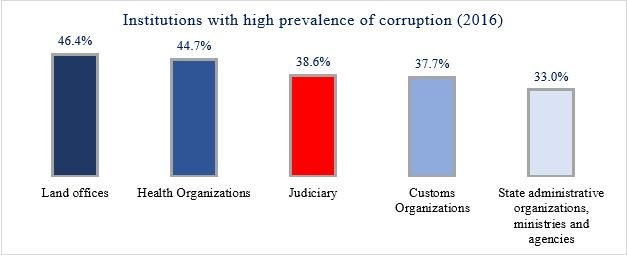
OVERVIEW OF THE SITUATION OF CORRUPTION IN JUDICIAL INSTITUTIONS OF MONGOLIA
Presenting the situation of corruption in judicial institutions of Mongolia, based on the results of the Integrity Assessment[1] (2016-2021) and the Survey on Perceptions of Corruption in the Judiciary and Law Enforcement Agencies[2] (2018-2021), organized by the Independent Authority Against Corruption of Mongolia (IAAC).
Results of the Integrity Assessment
According to the 2016 survey, the judiciary was the third most corrupt institution at 38.6 percent:
Chart 1. Institutions with high prevalence of corruption, 2016, in percent
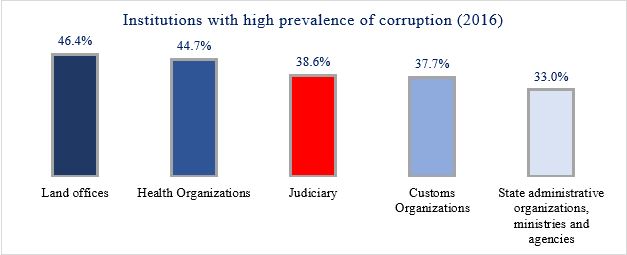
But, in 2018, this indicator increased by 10.6 percent and the rank moved up to the first place:
Chart 2. Institutions with high prevalence of corruption, 2018, in percent
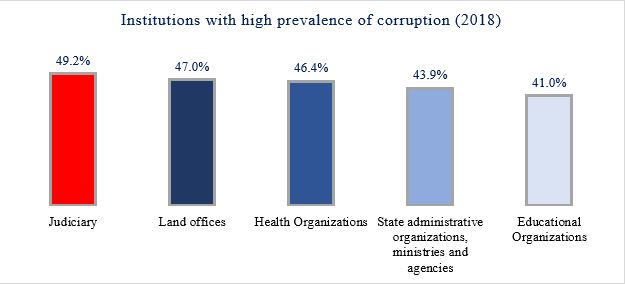
It can be seen that the percentage of corruption in the institutions ranked 2-5 in the list has also increased.
According to the 2019 survey, the assessment of the extent of corruption in the judiciary also increased by 4.1 percent and was ranked first again:
Chart 3. Institutions with high prevalence of corruption, 2019, in percent

According to the 2021 survey, the judicial institution’s performance decreased by 1.2 percent and ranked second on the list, but it was rated only 0.3 percent lower than the health institution. Although down slightly, this is still 9.4 percentage points higher than the sector’s 2016 figure (38.6%):
Chart 4. Institutions with high prevalence of corruption, 2021, in percent
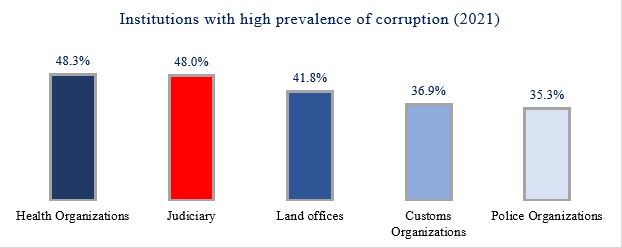
Thus, in the last 6 years, according to the assessment of the institution where corruption is most widespread, the judiciary is consistently ranked 1st-3rd in the list with 38.6-53.3 percent. The results of the 2021 survey showed a slight positive change, but conclusions will be available after the results of the 2022 assessment (currently being held) is released.
Results of the Survey on Perceptions of Corruption in the Judiciary and Law Enforcement Agencies
The 2018-2021 survey[3] examined perceptions of corruption within the judiciary and law enforcement agencies, including the following:
- Anti-corruption agency
- Border protection organizations
- Department of Citizenship and Immigration
- Forensic investigation organization
- Intelligence agencies
- Judiciary
- Organizations of court decision execution
- Police organizations
- Prosecution organizations
According to the study, when determining the extent of corruption in the judiciary, law enforcement sector, the judiciary was evaluated as follows:
Table 1. Scores obtained by the judiciary in the indicators of the extent of corruption in the judiciary and law enforcement sector

Thus, according to the survey of the last 4 years, in terms of the extent of corruption in the judicial and law enforcement sectors, the judiciary is consistently ranked 1st-3rd with 3.73-4.07 points.
The results of the 2021 survey showed a positive change, but the results of the 2022 survey (currently being held) show whether this change will be maintained or improved.
Complaints and information related to judicial institutions received by the IAAC in 2020 and 2021
In 2020 and 2021, the IAAC received a total of 166 complaints and information related to judicial institutions. In 2021, the share of complaints and information related to judicial institutions in the total number of complaints and information increased by 0.91 percent compared to the previous year:
Table 2. Number and percentage of complaints and information received by the IAAC in 2020 and 2021

Also, the number of criminal complaints and information related to judicial institutions increased sharply from 29 in 2020 to 51 in 2021.
The most complaints and information were filed about the following court institutions:
Table 3. Judicial institutions that most frequently mentioned in complaints and reports (2020, 2021)

In the last 2 years, the number of cases related to the Supreme Court (19), Bayanzurkh, Sukhbaatar, and Chingeltei District Criminal Court Offices (16) was the highest.
The IAAC annually registers the Declaration of Personal Interest, Assets and Income of judges of all levels of courts and conducts inspections. In addition, the summary of the Declaration of Assets and Income about 40,000 state and local government officials is publicly reported at http://www.xacxom.iaac.mn/.
In 2020 and 2021, the “Salkhit Silver Mine Case”, a sensational case related to judges and judicial institutions investigated by the IAAC since 2018, was decided by the first, appeal and review courts. In connection with this case, the powers of 17 named judges at that time were suspended by the order of the President of Mongolia and investigated by the IAAC.
Measures taken to reduce corruption in judicial institutions in Mongolia
The National Anti-Corruption Program (NACP) of Mongolia stipulates the implementation of 3 main measures to strengthen the fairness, transparency and independence of the judiciary and law enforcement agencies, and to improve anti-corruption cooperation. A brief introduction to the implementation of these measures from the compilation “Implementation of the National Anti-Corruption Program and Action Plan-2021”[5]:
- to enhance legal framework for ensuring the judiciary organisations to work independent from political parties and groups, to keep the selection and appointment process of judge and prosecutor fair, transparent and free from political influence (In clause 4.1.5.1 of the NACP);
On January 15, 2021, the Parliament of Mongolia approved the revised Law on Court of Mongolia, which entered into force on March 1, 2021. The Law on Court details the procedures for the selection of judges, the registration of candidates for judges, the examination of candidates, the process of submitting, appointing, creating, suspending and terminating judicial candidates. Therefore, a legal framework for the open and transparent process of selecting judges has been created.
The law clearly stipulates the process of appointing the members of the General Council of the Court, which is responsible for selecting judges, and the members of the Disciplinary Committee of the Court, which is responsible for suspending, dismissing, and imposing disciplinary sanctions on judges. In addition to clarifying the requirements for judges, there is a provision that prohibits the appointment of a person who has held a political or political party leadership position in the last six years.
The law stipulates that the General Council of the Court shall exercise full authority to assess the conditions and requirements for judges, to develop and approve selection procedures, and to organize their implementation. The General Council of the Courts’ Resolution No. 68 approved the “Judge Rotation Procedure”.
Also, in order to ensure the legal framework to protect the judge from interference, it was arranged that when a high-ranking official of a political or law-enforcement organization meets with a judge on official work, a record should be taken and given to the official in charge of confidentiality of that court organization.
In addition, it was enacted that if these organizations and officials made decisions or conducted activities that undermined the independence of the courts and the independence of judges, they would be dealt with by the Constitutional Court. In other words, the process of ensuring the independence of the judge and protecting the legal interests of the judge is clearly defined.
According to Resolution No. 49 of the General Council of the Court, “Procedures for maintaining, recording, and resolving influence declarations”, “Influence declaration template”, “Documents presented about influence declaration”, “Record of Influence declaration”, “Record of notes”, “Sample of certification mark” were approved respectively.
In 2021, a total of 4 influence declarations were submitted by 4 judges, 1 of which was dismissed according to the Amnesty Law, and 3 were transferred to the police for investigation.
Prohibitions are detailed for judges. These prohibitions became the code of ethics for judges, and the Disciplinary Committee of the Court handled complaints and information about violations. Also, regulation of interests of judges, duty to declare assets and income of judges and their family members, restrictions on civil rights of judges, and violations in this regard will be resolved by the Disciplinary Committee of the Court. In other words, the ethical norms of judges are established by law.
- to establish and implement a common procedure at all levels for selecting managerial level officials of judiciary (In clause 4.1.5.2 of the NACP);
According to the Law on Court, the Chief Judge of all levels of courts must meet the following requirements and some special criteria, in addition to the conditions specified in Section 3 of Article Fifty-one of the Constitution of Mongolia[6]: have not faced criminal charges, have not been accused at the time of candidacy for judges, have diseases or mental illnesses that are incompatible with working as judges. having a certificate from an authorized medical specialist who has determined that he is free of illness, having a license to practice law, and having the knowledge, ability, and ethics to work as a judge. Specific requirements include that the appellate court judge must have served as a judge in the court of first instance for at least six years.
The selection of the Chief Judge of the court shall be discussed and decided by the Council of Judges, which consists of all the judges of that court. The law stipulates that the Chief Judge of the Court of First Instance and the Court of Appeal shall be elected for a term of 3 years and may be re-elected once. As the Chief Justice of the Supreme Court, he must have worked as a judge for at least 10 years, and according to the suggestion of the Supreme Court, the President shall be appointed only once for a period of 6 years.
- to renew the education curriculum for judges and prosecutors, and to improve their professional skills (In clause 4.1.5.3 of the NACP);
The law stipulates that the Judicial Training, Research and Information Institute under the Supreme Court will be responsible for the training of judges, and this institute was established in August 2021 and started its activities.
In 2020, 13 newly appointed judges attended training on “Conflicts of interest and issues to be considered”, “Investigation of officials, issues to be considered”, and judges in criminal cases were trained on “Issues to be considered in the handling of corruption crimes”.
In recent years, the Anti-Corruption Agency has organized the “Integrity and Public Confidence” conference[7] and the “National Anti-Corruption Conference”[8] for civil servants and citizens working in the judiciary and other sectors. Also, books and manuals for judges and prosecutors have been published and corruption prevention training has been conducted regularly.
Further on …
According to recent results of the Integrity Assessment and the Survey on Perceptions of Corruption in the Judiciary and Law Enforcement Agencies, judiciary institution is consistently named as the most corrupt institution. Both survey results show a slight improvement in 2021, but it is unclear whether this positive trend will be sustained or further improved. The 2022 results of the above two types of survey are not yet available, so it is difficult to predict.
It is expected that the Law on Court, which came into force on March 1, 2021, will be a legal framework that will have an important effect on reducing and eliminating corruption in this sector.
Although the legal environment has changed in a positive direction, the selection and appointment of judges within the framework of the new law has only started in 2022, so it is not yet time to draw a reasonable conclusion.
The report[9] shows that there is a lack of training programs and training for judges to prevent corruption and conflicts of interest and to improve their professional skills. Efforts to change this weakness need to be intensified by courts, judicial administration and the IAAC. Research-based, effective and innovative training programs and other measures aimed at reducing and eliminating corruption in the judiciary institution should be planned within the newly developing NACP of Mongolia.
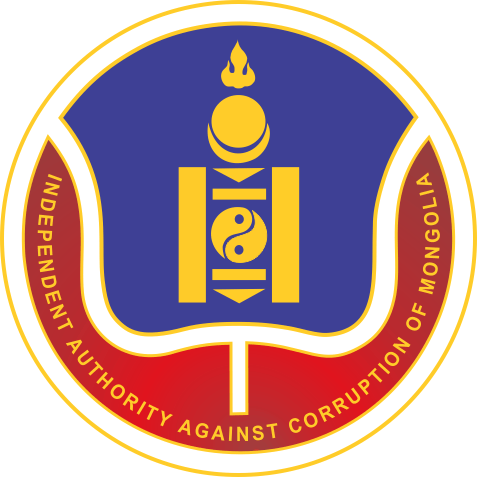
For further information, please contact:
Erkhemjargal Odsuren, Officer, Research and Analysis Division
Independent Authority Against Corruption of Mongolia
erkhemjargal@iaac.mn
[1] Report link (in Mongolian): https://iaac.mn/posts?category_id=13937
[2] Report link (in Mongolian): https://iaac.mn/posts?category_id=13939
[3] Report link (in Mongolian): https://iaac.mn/posts?category_id=13939
[4] It is rated on a scale of 1-5, with higher scores indicating more corruption.
[5] Compilation link (in Mongolian): https://iaac.mn/post/104473
[6] Constitution of Mongolia (in English): https://legalinfo.mn/mn/edtl/16230947950271, Constitution of Mongolia (in Mongolian): https://legalinfo.mn/mn/detail/367
[7] Report link (in Mongolian): https://iaac.mn/post/90661
[8] Report link (in Mongolian): https://iaac.mn/post/104502
[9] Compilation link (in Mongolian): https://iaac.mn/post/104473





